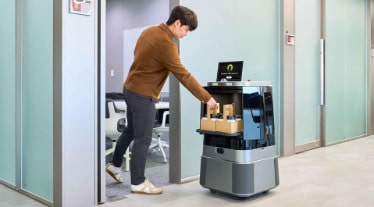Tech firms have announced the development and testing of robotic systems with biometric capabilities aimed at enhancing operational efficiency and security surveillance.
Hyundai Motor Group, for instance, has created robotics that integrate facial recognition for smart buildings. Similarly, Kody Technolab has deployed surveillance and service robots at the Tuneland Music Festival in India.
In addition, countries like the United States and China are incorporating rifle-armed robot dogs into their militaries.
Hyundai develops intra-building delivery robot for smart office
Hyundai Motor Group has designed the DAL-e Delivery, an autonomous robot for intra-building delivery. It is equipped with an AI face identification system for navigation within the smart office environment of Factorial Seongsu in Seoul. The biometric integration allows the robot to enhance security and efficiency by identifying delivery recipients.
For autonomous navigation, the DAL-e Delivery robot is synced with the building’s elevator and door control system, enabling it to move freely across different floors and rooms. It is equipped with an 11.6-inch high-resolution display that provides detailed information about the service status to operators and recipients.
“With DAL-e’s full-fledged delivery service, we aim to make Factorial Seongsu the first building to apply our Robot Total Solution,” says Dong Jin Hyun, vice president and head of Robotics Lab at Hyundai Motor Company and Kia Corporation.
In its efforts to provide comprehensive robotic solutions integrating various robotic services and facial recognition systems within smart buildings, Hyundai also developed a parking robot. This smart parking control system can simultaneously manage up to 50 parking robots, coordinating movements in tight spaces.
Crowdfunding for personal AI companion robot
After two successful robotic crowdfunding campaigns, Luwu Intelligence has introduced another project: XGO-Rider, a desktop wheel-legged robot. The module integrates image-based AI features such as gesture recognition, face detection, and skeleton recognition using the TensorFlow-based MediaPipe framework.
The XGO-Rider robot leverages the Raspberry Pi CM4 core module to improve personal AI companionship and mobility. The open-sourced robotic platform uses OpenAI’s API for voice-based AI functionalities. “With XGO-Rider, we aim to redefine personal robotics, empowering users to explore new possibilities and interactions in their everyday lives,” says PengFei Liu, chief executive officer of Luwu Intelligence.
Robot with facial recognition at music festival in India
During the recent Tuneland Music Festival in Gandhinagar, India, Kody Technolab deployed two of its robotics -– known as Athena and Dasher — to handle security and service tasks, ensuring the safety of more than 35,000 attendees.
Athena is equipped with 360-degree cameras that provide high-definition recording coverage of the festival grounds. Its advanced computer vision capabilities enable the robot to capture vehicle plate numbers and associate them with specific locations, facilitating vehicle plate recognition and monitoring of vehicles within its operational area.
Athena also incorporates a facial recognition system, according to a post on the Interesting Engineering blog. The lack of clarity on the specific databases used for this purpose is raising privacy and security concerns.
“The deployment of Athena and Dasher at the Tuneland Music Festival is a testament to the vast possibilities that robotics holds for improving both security and service in public spaces,” says Manav Patel, founder of Kody Technolab Limited.
Chinese, US militaries add new robotic weapons to their arsenal
The Chinese military unveiled the Go2 robotic weapon, a gun-wielding robotic dog, during joint military exercises with Cambodia, as reported by CNN. This robot dog is armed with an automatic rifle mounted on its back and is accompanied by a similarly equipped quadcopter.
In a YouTube video showcasing the Chinese Go2 robot dog, a soldier can be seen controlling it with a handheld device, indicating that human oversight is still required for its operation. Despite their advanced capabilities, both the robotic dog and drone appear to have been modified for consumer products.
Article: Robots integrate biometrics for parcel delivery, security, and military operations


